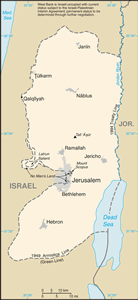The Geography of West Bank
The Geography of West Bank
NA Geography
Location: Middle East, west of Jordan
Geographic coordinates: 32 00 N, 35 15 E
Map references: Middle East
Area: total: 5,860 sq km land: 5,640 sq km water: 220 sq km note: includes West Bank, Latrun Salient, and the northwest quarter of the Dead Sea, but excludes Mt. Scopus; East Jerusalem and Jerusalem No Man's Land are also included only as a means of depicting the entire area occupied by Israel in 1967
Area - comparative: slightly smaller than Delaware
Land boundaries: total: 404 km border countries: Israel 307 km, Jordan 97 km
Coastline: 0 km (landlocked)
Maritime claims: none (landlocked)
Climate: temperate; temperature and precipitation vary with altitude, warm to hot summers, cool to mild winters
Terrain: mostly rugged dissected upland, some vegetation in west, but barren in east
Elevation extremes: lowest point: Dead Sea -408 m highest point: Tall Asur 1,022 m
Natural resources: arable land
Land use: arable land: 16.9% permanent crops: 18.97% other: 64.13% (2001)
Irrigated land: 150 sq km; note - includes Gaza Strip (2003)
Natural hazards: droughts
Environment - current issues: adequacy of fresh water supply; sewage treatment
Environment - international agreements:
Geography - note: landlocked; highlands are main recharge area for Israel's coastal aquifers; there are about 340 Israeli civilian sites--including 100 small outpost communities in the West Bank and 29 sites in East Jerusalem (July 2008 est.)


